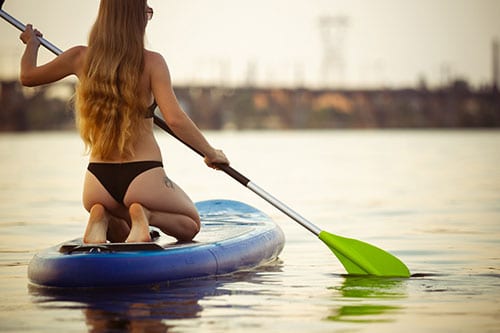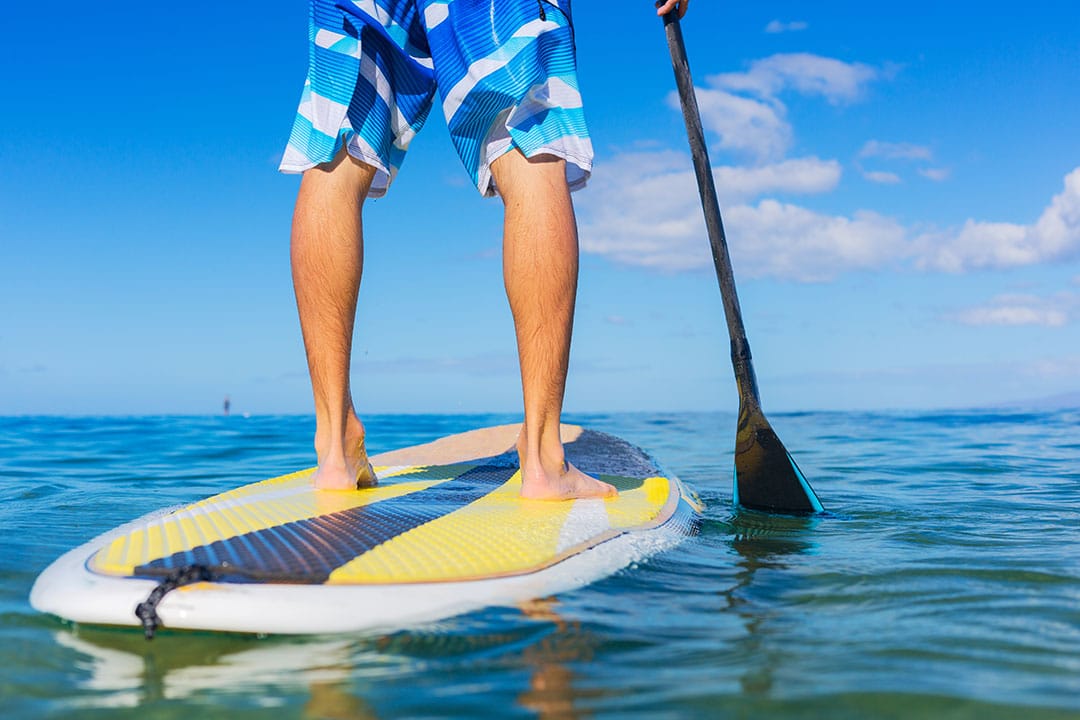Stand-up paddle boarding is a rapidly-growing watersport that is far easier than surfing or waterskiing, but offers many of the same great benefits.
Unlike surfing, which requires waves, or waterskiing, which requires a boat, stand-up paddle boarding is also a self-contained activity that can be done on any body of water (as long it’s wide enough to be safe).
If you’ve been longing to move some of your fitness routine out onto the water, but have been marooned by the learning curve of a lot of water sports, paddle boarding may be just the launching point you need.
What is stand-up paddle boarding?

Stand-up paddle boarding is basically its own definition.
It is standing on a board (similar to a surfboard) on a body of water and using a paddle to make that board move.
What does SUP mean in paddleboarding?
When you first start looking into stand-up paddle boarding, you will likely see the term SUP used repeatedly.
SUP is simply an acronym for Stand-Up Paddleboarding, so it means the exact same thing.
Benefits of Stand-Up Paddleboarding
Stand-up paddle boarding is a full-body, weight-bearing sport that requires self-propulsion.
So, it works the entire body and has a host of head-to-toe benefits.
Some benefits of paddle boarding for those who create and stick to a routine include:
- Improved strength (full body)
- Improved flexibility
- Improved balance
- Improved joint health (paddle boarding is low-impact)
- Improved sleep
- Enhanced immune response
- Fresh air and quiet time in nature, which in itself can:
- Decrease stress
- Lower blood pressure
- Enhance immune response
- Bolster self-esteem
- Reduce anxiety
- Reduce aggression
- Improve overall mental health

While paddle boarding can also lead to improved heart health (including lower blood pressure), improved respiratory rates, and weight loss, these benefits are not as immediate or as easy to achieve as paddle boarding’s strength and flexibility benefits.
A study on the benefits of paddle boarding by the American Council on Exercise found that beginner paddle boarders did not reach a beneficial average heart rate when allowed to paddle at their own chosen pace.
The same study showed experienced paddle boarders did, however, reach beneficial target heart rates while paddle boarding.
So, while cardio and respiratory benefits are possible with paddle boarding, they are something to work toward and not something you will get immediately as a new paddle boarder.
Is paddle boarding easy to learn?
As far as water sports go, paddle boarding is a fairly easy sport to learn.
For more on the difficulty level of paddle boarding, see “Is Paddle Boarding Hard?”
Can you sit on a paddleboard?
Yep. You can sit (or kneel) on a paddle board. In fact, there are several paddle board seating accessories designed for that very purpose.

You won’t get the same workout sitting on a paddle board as you will standing (you do a little better with kneeling), but sitting can be a great way to ease into paddle boarding if you’re a little hesitant about your balance or stamina.
Can I paddleboard every day?
Most of the time, the answer is, ‘Yes, paddle boarding is such a low-impact exercise you can do it every day.’
But paddle boarding can also be tiring and put stress on the areas that do most of the work – your arms, shoulders, back, and (to a lesser extent) your core.
So, when deciding whether to go out for another paddle boarding session a second day in a row, keep in mind that tired and sore muscles are weak muscles more prone to injury.
If your muscles feel heavy or sore after you paddle board, they are not strong enough to handle the load yet. (This is especially likely when you first start paddle boarding and are new to the movements.)
Skip a day to recover so you don’t have to skip several days with injury.
Over time, as you get used to paddle boarding’s stance and technique, you will likely be able to paddle board every day without issue.

Is paddle boarding a good workout?
When done with intention, paddle boarding can be a good workout.
It works muscles in both the upper and lower body and can keep the heart rate up over a long period of time.
But you must put enough effort in.
Much like with walking, a leisurely paddling pace won’t suffice if you are paddle boarding for fitness.
Is paddle boarding good cardio?
Again, how good of cardio paddle boarding is depends entirely on the effort you put in.
At a leisurely pace, paddle boarding won’t raise your heart rate enough for cardio benefits.
But you can get there.

When paddle boarding for exercise, you just need to know that you’re paddle boarding for exercise and give it your all.
This may be difficult when first starting out and the paddling/balancing on your paddle board isn’t as instinctive, but as you get better at paddle boarding, the better of a cardio exercise it has the potential to become.
Can you lose weight paddle boarding?
Yes, you can lose weight paddle boarding.
It’s all about getting into those cardio ranges as discussed above.
Calories Burned Paddleboarding
Since paddle boarding’s effectiveness (like many activities) is so tied to effort, the calorie range for calories burned while paddle boarding is, unsurprisingly, quite wide.
In the American Council on Exercise study of paddle boarding efficacy, researchers found calorie burn to be between 228 and 327 calories in 30 minutes for women and between 312 and 507 calories in 30 minutes for men.
The paces used to determine calorie-burn were moderate to high-intensity and the lowest calorie-burn was 7.6 cal./min – quite the decent calorie expenditure.
Can you build muscle paddleboarding?
Yes, you can build muscle paddle boarding.
Like other exercises that use your own body weight vs. static resistance (in this case, the weight of the water), you are unlikely to build much muscle through paddle boarding.
What you will do is strengthen the muscles that you use and burn fat (if you reach those cardio zones), creating more visible definition in your muscles.

What muscles does paddleboarding work?
Almost all of them.
While your lower body won’t get the same workout as your upper body since it remains largely stagnant, you will engage your leg muscles and glutes to stay still and balanced on the board.
Often, even your feet.
Up top, you’ll use everything from your shoulders to your waist during a paddle stroke, and the more complete your strokes are, the more (and deeper) the muscles you’ll use.

More specifically, paddle boarding engages the following muscles:
- Shoulders
- Back
- Chest
- Arms (biceps, triceps and forearms)
- Hands
- Core muscles (abs and obliques)
- Glutes
- Legs (hamstrings, quadriceps, calves)
- Feet
What’s more, the act of maintaining balance on and paddling a paddle board uses many of these muscles differently than they are used in day-to-day activities, increasing the utility of paddle boarding workouts for overall fitness.
Stand-Up Paddle Boarding for Beginners

The basic technique for paddle boarding is simple. It is just a matter of finding a good stance that helps you maintain your balance and proper paddling.
If you can keep centered on your paddle board and paddle, you should be able to navigate calm waterways without instruction.
Translation: Most people do not need a lesson to get started paddle boarding.
Paddle boarding is one of those balance-heavy activities where you really need to get a feel for being on the board anyway, and, while people can give you tips on how to balance, no one can really help you do it.
So, to some extent, everyone ends up learning how to paddle board on their own, or at least practicing technique on their own before they get fully comfortable on their boards.
If you want to try your hand (and your feet!) at paddle boarding on your own, check out our simple tips for new paddle boarders at Stand Up Paddle Boarding Tips for Beginners.
SUP Lessons
Even though you can likely figure out paddle boarding on your own, and we don’t want to discourage you from just hopping on a board and setting out if that’s what you’re into, we will mention that paddle board lessons CAN prove beneficial.
A paddle board instructor will teach you how to get onto and off of your board and provide guidance on stance and proper paddling technique.
For most people, one lesson is all it will take to pick up the essentials of paddle boarding and decide whether or not paddle boarding is the right water sport for them.

You can find paddle boarding lessons just about anywhere you find paddle boarding.
- Here’s one at Lake Mead near Las Vegas.
- And one in the beautiful Puerto Vallarta, Mexico.
- And a group lesson in Kihei, Maui, Hawaiii.
Click here to look for SUP lessons near you.
Looking for something in between learning on your own and a formal lesson?
Consider renting a paddle board your first time out that offers a quick lesson along with your rental.
Many paddle board rental companies will give you a crash course in how to use their boards if you tell them it’s your first time.
It will cut into your rental time, sure, but it can be a great value for guidance in the basics.
Best Paddle Boards and Equipment For Beginners
When you’re ready to start paddle boarding, you absolutely need four things:
- A paddleboard (inflatable ones are great for beginners)
- A paddle
- A leash
- A personal flotation device (PFD)
For more on why you MUST have these four items, see Stand Up Paddle Boarding Tips for Beginners.

But, while these things are all you actually NEED to get started with paddle boarding, for the sake of comfort and protection from the weather, you’ll likely want a few other items/accessories as well.
For how to dress while paddle boarding, why and when to wear a wetsuit, and accessories that can upgrade your paddle boarding experience, see:
- What To Wear Stand Up Paddle Boarding
- Stay In The Water Longer With The Best Wetsuits for SUP and Surfing
- Don’t Paddle Board Without These 14 Must Have SUP Accessories
Why Stand-Up Paddle Boarding?
Stand-up paddle boarding may not be the most effective cardio exercise you can do (or a cardio exercise at all when you’re first starting out), but it does get your entire body working in unison.

Balancing and paddling a paddle board can help tone your legs, shoulders, arms, back and core, leading to improved strength, balance, and flexibility.
Over time, once you nail down the basics, you can increase your output on a paddle board, boosting its cardio and aerobic effectiveness.
Not to mention, the other forms of paddle boarding you can try, such as SUP surfing, that pit you against greater resistance and require more balance, taking your SUP workouts to a whole other level.
Before you get there, though, there is basic paddle boarding, which is considerably easier to learn than surfing, water skiing, and many other water sports.
So if you’ve been looking for a water-bound activity that won’t take weeks or months to get the hang of, is fun, and can eventually serve as a decent workout, a paddle board may be just the thing to finally carry you away from the shore.
Looking for motivation to get out onto the water? Check out our Inspirational Paddle Board Quotes (SUP Quotes).
Want more yuks with your SUP content? Check out our Stand-Up Paddle Board Puns That Will Have You Row-ling.
